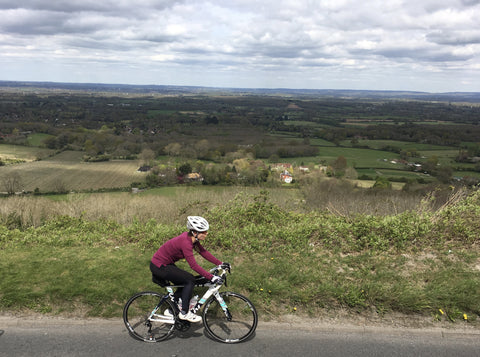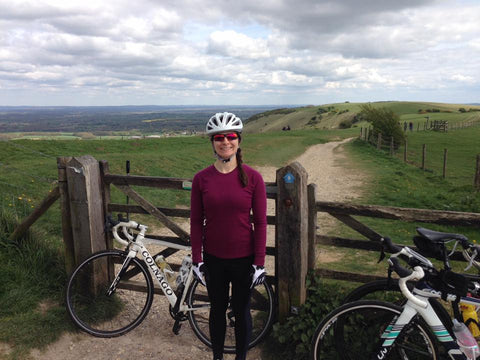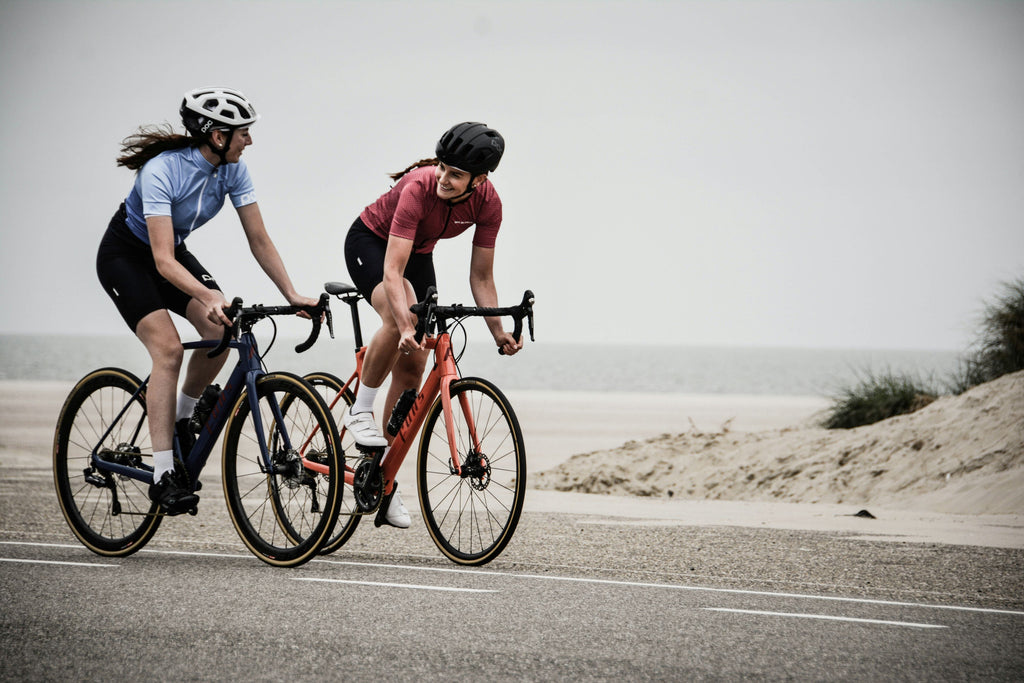Buying a New Bike - A Female Cyclist's Story
Buying a new bike is a daunting, beguiling and sometimes overwhelming experience for new cyclists. It's a scary prospect for the 'uninitiated', so when Kate Siddiqui, one of our members, offered to write a blog on her bike buying experience, we bit her hand off! Continue reading below for Kate's story, followed by her bike buying top tips:
Come January many of us start with the “New Year, New You” mantra, and this year I was no different. My road bike had sadly been stolen, so with my insurance payout in one hand, a Cycle to Work voucher in the other, I set out to get a new bike.
The added motivation to my “New Year, New You” mindset was the fear/foreboding of an Alpine road cycling trip looming in late summer, and I knew I needed to get some serious training miles in.
Unexpected climbs
Having shortlisted a handful of brands and frames from online research I called around 3 or 4 local bike shops - both small suppliers and your well-know Evans and Cycle Surgery stores - expecting my healthy budget and request for a women’s carbon frame bike would be met with enthusiasm.
My experience at this point was not encouraging. Primarily I was met with a sharp intake of breath and a “we don’t stock any/many carbon women’s… and we don’t have that brand/frame size in stock.”
It was here that I started to realise that this may not be the quick and easy shopping spree I’d expected.
Over the next 5 weeks I spent many an hour trawling around cycling shops all over London, looking at their selection, speaking to the staff, and trying different brands and frame sizes.
It was of course a good problem to have, but it was also fairly exhausting and overwhelming, and I worried I wouldn’t get a bike sorted in time to get in some of those all important winter miles.

The more you know, the more you know how little you know!
The sheer number of shops I visited meant I was getting lots of advice and opinions from the shop staff. This was both positive and negative. I learnt more, and heard different perspectives, but it was also very confusing.
Everyone has different opinions which I found to be both contradictory and not directly comparable. I took each tip and added it to my bank of knowledge and reminded myself that the staff in bike shops are trying to sell their wares.
Feeling lost and anxious that I’d misspend my investment, and totally uneducated in anything bike, I set about on a mission to understand what I was actually doing.
Here’s where messages, phone calls and conversations with many people came into play - the cycling work colleague, my weekly cycling buddy, the occasional cycle buddy, school friends I hadn’t spoken to in years, physios, other people’s husbands - basically ANYBODY who could stand my inane bike chat and incessant questions was bombarded with them.
Over time my knowledge grew and I felt better equipped to make an informed decision about what I was buying.
Finding The One
I tried out lots of bikes - some I just hopped on and off quickly and it was an immediate ‘too small’ or ‘too big’. Some I got rigged up on the turbo and spent a few minutes peddling, and around three I actually took out on the road for a trial. Realising what I was looking for was part of my journey.
During the process I was regularly spinning at a spin studio in the City, and I played around with the bike settings here to see what I thought was comfy - moving the handlebars and seat position to see what made me feel most powerful (technically this should have been reflected in my wattage stats - but let’s be honest they’re still too embarrassing to mention anywhere public!).

The moment I sat on my new bike - a Liv Envie Advanced 2 - I actually cried a little with joy. Don’t worry, none of the cool cycle guys in Cadence Performance saw, as I was wearing my sunglasses at the time (*phew*).
It fitted like a glove and was what I deemed to be a reasonable spec for the spend. It was a moment where all my perseverance paid off and a huge amount of relief that I could get on with training into the spring.
Turns out my instinct on what geometry suited me, developed over weeks of trialling bikes and a sporty background, was right. When Sandro from Cadence took me through a Retul bike fit, it only needed minor adjustments to be the perfect set-up.
The final descent
So what are my takeaways? Educate yourself. Be that annoying person who asks 1000 questions - don’t be intimidated by people’s tone of voice which may come across as patronising.
They’ve often forgotten what it’s like to be new to this, so just ignore them and get on with it.
Whether you’re spending £500 or £5000 it’s your choice, and your bike, so make sure you’re comfortable and don’t be pressured into anything.
Call on the support of your cycling community, as they’ll be able to give you more time to talk and a more rounded opinion than shop staff who are incentivised to sell.
Finally, I don’t believe shopping for a women’s bike is the same as shopping for a man’s bike. There’s less in stock to try out, less engineering and science invested in women’s cycling, and 80% of the time you will be speaking to shop staff who are men.
But as all good cyclists know, nothing is an insurmountable climb, and when you reach the top the view is beautiful.

Kate’s Top Tips for Buying a New Bike:
Now I’m on the road to becoming a fully fledged bike nerd, it’s time for me to share some of my hard-learnt wisdom. If you’re new to road cycling, looking to buy your first bike or upgrade, the tips below are for you.
There is quite a lot online about the various components (gears, brakes, pedals, etc) and any cycling bloke will be able to give you a full rundown of these, probably because these are consistent across male and female bikes.
So instead of repeating what you can probably already find, here are some tips aimed towards newer cyclists, and the female rider, specifically around how to shop for the right frame geometry:
- Most brands have an ‘endurance’ model and a more sporty model you’ll hear referred to as ‘aggressive’ ‘racer’ or ‘aero’. People will generally recommend an ‘endurance’ model if you’re doing long distance road cycling, and the ‘aggressive/racer/aero’ style for time trials, triathlons and short distance stuff. There’s sense in this, but the split isn’t hard and fast, because each brand and model have unique geometries. I’ve ended up with a bike advertised as ‘aero’ but for me it’s a comfy fit for road cycling and the occasional triathlon.
- Choosing the right frame size is very important to get right as it’ll help you feel comfortable on the bike and not develop any injuries. What you must know is that brand to brand, the frame geometries are not comparable. So a 48cm frame in one brand may will likely be completely different to a 48cm in another brand, and some just called them ‘XS, S, M’ and do away with the numbers all together. So just try the frames and see what works best.
- The geometry of the frame will remain consistent across the different price ranges of the model, it’s just the components (brakes, gears, wheels) will get more fancy depending on how much money you’re spending, or change depending on the usage of the bike. So for instance the Liv Envie range have the ‘Advanced’, the ‘Advanced Pro’ and the ‘Advanced Tri’.
- Most shops won’t stock a big range of women’s bikes (especially in the carbon frame price bracket), but you can try the same brand/model with the aluminium frame and less high value components as the frame geometry will be consistent across the model. Know what you’re getting with the components, but hopefully it’s takes the pressure off to be told that they’re generally accepted to be a fair quality for their price in all the major brands and retailers.
- You’ll see bikes advertised as “men’s” “unisex” and “women’s”. What’s the difference I hear you ask? Many women’s bikes simply have a shortened top bar and narrower handlebars, but remain essentially the male geometry. Who knows how they decide it’s “unisex”, it’s probably just marketing twoddle. In all the research I did I only remember the Liv range being able to boast that it’s built from bottom up using all the science and engineering available in the industry to develop the women’s frame. Trial and error is the only way to know what’ll work for you.
I hope my experience and tips will help you in your bike buying quest. Good luck and see you on the road soon!
Thanks for the amazing blog Kate Siddiqui. If you have any questions about buying a bike then please comment below, or link up with us on Twitter or Facebook. Or you can do it the old fashioned way and Email Us.
Main image: Photo by Coen van de Broek on Unsplash


